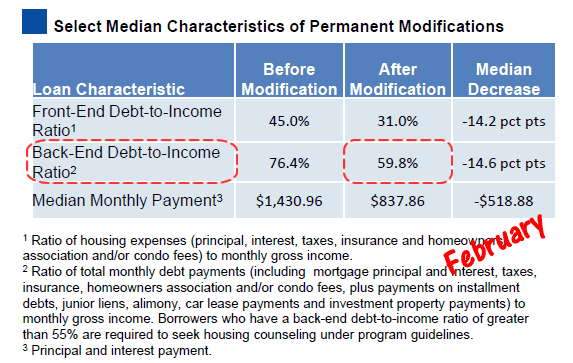U.S. Housing Market Debt, The Government’s Loan Mod Bizarro World
Housing-Market / US Housing Apr 16, 2010 - 02:49 AM GMTBy: Tim_Iacono
 Just when you think that the statistics can’t get any worse for the graduating class of the Obama Administration’s Home Affordable Modification Program, they do. Otherwise known as HAMP, this program is apparently designed to convince people who really can’t afford their current debt load that they really can.
Just when you think that the statistics can’t get any worse for the graduating class of the Obama Administration’s Home Affordable Modification Program, they do. Otherwise known as HAMP, this program is apparently designed to convince people who really can’t afford their current debt load that they really can.
To that end, it is meeting with modest success.
How else can one explain that total debt-to-income ratios have risen even higher than February’s ridiculous burden of just under 60 percent as noted in this item four weeks ago?

Over the last four weeks, some 60,000 HAMP “trial” participants have had their loan modifications elevated to “permanent” status, meaning that they can now go confidently forth into the world thinking that their impossible debt load is somehow under control.
It’s not.
As shown below, the median back-end debt-to-income ratio has now climbed to over 61 percent with no upper limit in sight (no, you can’t go over 100 percent, but that doesn’t mean they won’t try – just make sure you get that counseling as detailed in note 2).

What is even more astonishing about this data is that things are getting worse very quickly, much faster than the 1.5 percentage point increase in total debt service as shown above.
Consider that, in February, there were 170,000 “permanent” loan mods and, last month, another 60,000 joined their ranks. A quick calculation reveals that, in order for the new graduates to raise the overall median from 59.8 percent to 61.3 percent, the median back-end debt-to-income ratio for the next 60,000 had to be somewhere around 65 percent!!
Sixty five percent!!
How can these people possibly afford to pay their taxes, service their debt, and then have enough money left over to put food on the table and pay their utilities, let alone buy gasoline, clothes, and sock away a little money for retirement?
The government must be living in some kind of loan mod “bizarro world” to think that these “permanent” loans won’t go bad on a massive scale.
That assessment of the government’s grasp on reality was confirmed in this NY Times story the other day when Shaun Donovan, secretary of Housing and Urban Development uttered these rather remarkable words:
Given how stressed these borrowers are, even in the best situation, there will be redefaults. But I don’t think there is any evidence that would cause us to worry at this point.
Of course not…
They’ve got enough to worry about getting people out of old debt burdens that they couldn’t manage into new, slightly lower debt burdens where they have little or no chance of survival either.
Julia Gordon of the Center for Responsible Lending was also quoted in the NY Times story and provided a much more realistic view of things:
It’s definitely alarming to look at those statistics. The current model for modifications doesn’t necessarily produce sustainable results.
Well, maybe that was never the plan.
The record shows that more than half of the loans modified in late-2008 ended up redefaulting within a year and, with debt-to-income levels as high as that being produced by HAMP, you’d expect that success rate to be just a pipe dream for HAMP.
 Truly startling is the realization that these 230,000 “permanent” loan modifications represent the current cream of the crop, one that appears to be less creamy every month.
Truly startling is the realization that these 230,000 “permanent” loan modifications represent the current cream of the crop, one that appears to be less creamy every month.
Of course, this is working out rather nicely for the banks.
While the”homeowner” gets a slightly lower mortgage payment, thanks to freakishly low interest rates subsidized by the Treasury Department, the banks get to carry these loans on their books at full value, as if they’ll ultimately be repaid.
And, better yet for other banks, second mortgages are not touched during these loan modifications. In fact, in many cases under their new monthly payment regime, homeowners will be writing out a larger check for their home equity line of credit or second mortgage than for their first mortgage where the payment has been lowered thanks to Uncle Sam.
Clearly Elizabeth Warren had it right yesterday when she told “homeowners”:
Some of you should stay in your homes…and some of you don’t belong in those homes and you’ve got to be moved out. And frankly, those houses need to get back onto the market and get into the hands of people who can afford them. In other words, acknowledge the problem, deal with it, write off the losses and start rebuilding an economy on solid ground.
Now that sounds like a good plan.
The bad news is that, in the government’s eyes, “extend and pretend” appears to be the order of the day – extend the period of time that banks keep getting sent monthly mortgage checks while pretending that all of the borrowed money will somehow be repaid.
By Tim Iacono
Email : mailto:tim@iaconoresearch.com
http://www.iaconoresearch.com
http://themessthatgreenspanmade.blogspot.com/
Tim Iacano is an engineer by profession, with a keen understanding of human nature, his study of economics and financial markets began in earnest in the late 1990s - this is where it has led. he is self taught and self sufficient - analyst, writer, webmaster, marketer, bill-collector, and bill-payer. This is intended to be a long-term operation where the only items that will ever be offered for sale to the public are subscriptions to his service and books that he plans to write in the years ahead.
Copyright © 2010 Iacono Research, LLC - All Rights Reserved
Tim Iacono Archive |
© 2005-2022 http://www.MarketOracle.co.uk - The Market Oracle is a FREE Daily Financial Markets Analysis & Forecasting online publication.



